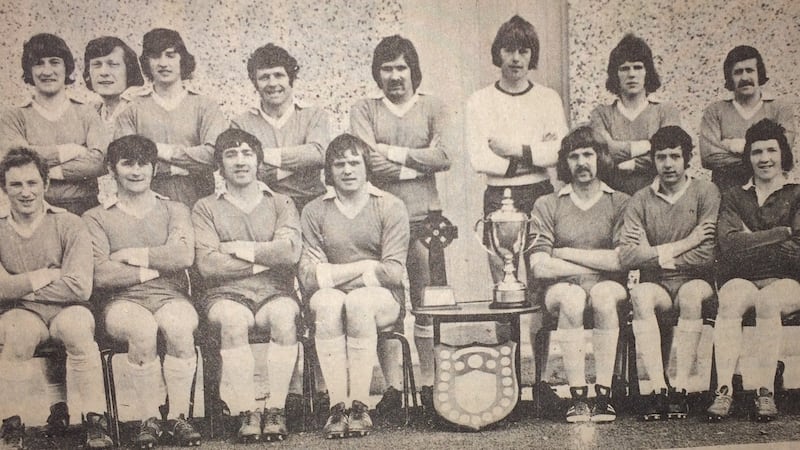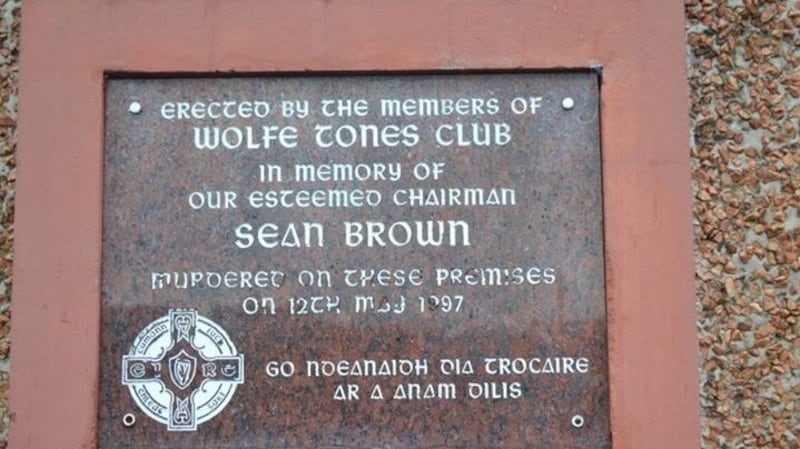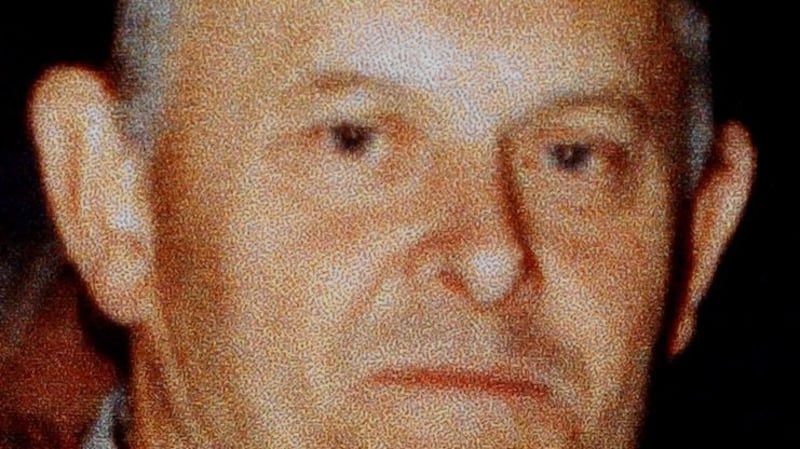The 1971-72 season produced the greatest year in the history of Bellaghy Wolfe Tones GAC. Ignoring the brewing threat of the Troubles, they would conquer the Derry and Ulster club championships before becoming All Ireland champions in May ’72. The best of times.
Instead of heralding a prosperous future of success however, that one glorious year would sustain them through darkness that would follow, the conflict ripping through the community over the following three decades.
And exactly 25 years to the day of their greatest success, the club endured their darkest of many dark days. The worst of times.
This is the story of a club that lived through terrible times of agony and heartbreak, using fond memories from an All-Ireland-winning season to distract from the brutality of their surroundings.
***
Croke Park had never witnessed the echoing Mid-Ulster twang reverberate around the arena as it did on May 12th, 1972.
The South Derry community of Bellaghy knew how to celebrate success, but this was another level. This was an All-Ireland title, earned against the Sigerson Cup kingpins, UCC.
"There were women and men who you wouldn't have seen at football," says Chris Brown, a wing-back on the team, remembering the ecstatic scenes greeting players at the final whistle.
It was a special summer evening, even if this now-treasured competition wasn’t treated with the same esteem back then. A selection of ledes in reports the following day offers an insight into where it belonged in the wider public psyche.
Many of the match reports focussed on Brendan Lynch, the star Kerry and UCC forward, not the humble Ulster club who had risen to become club kings of Ireland. An injury sustained by Lynch in the encounter meant his participation in the league final two days after the club decider was now in jeopardy.
But that didn’t take away from the elation on display in Drumcondra’s Skylon Hotel in the hours following the game and up the road in Bellaghy the following evening.
Furthermore, the club was now expecting to scale new heights. National dominance, they felt, was on their doorstep.

“I have no doubt that we could’ve beaten any club team before or since,” says Austin Mulholland, a full-back in the side. “We knew we were always special.”
The hangover alas was looming.
A cursory glance at the front pages of the following morning’s papers was all that was needed to remind Ulster folk of the developing situation awaiting them back home.
A man shot with four others injured in west Belfast.
Bloody Sunday soldiers avoiding disciplinary hearings.
Republican and Loyalist prisoners had staged a siege within a Belfast prison.
The latest updates on the bombing campaign swelling through the province.
All this before a single page was turned.
It was from within this world that the club from Derry emerged; and this would be the world to which they’d return.
Terrible time
Not only had Bloody Sunday occurred a short distance away in Derry, civil rights marches had become a common occurrence nearby, events which threw Bellaghy straight into the eye of the maelstrom during the conflict’s early years. And if they needed an incident to bring them down from whatever clouds they were riding on in the aftermath of their victory in Croke Park, it promptly arrived.
Approximately a fortnight following their triumph, the Gaelic Hall, the club’s headquarters before the construction of their clubhouse, was burned to the ground. Sectarianism had become Bellaghy’s new norm and any presumed dominance was facing considerable obstacles. Unrest in the North was here to stay.
“It was devastating but it was where it was at,” says Brown. “We were non-political and non-sectarian – I’d stand over that with anyone. That was the way the GAA was – certainly from where we were at.
“Because of what was happening around south Derry, I think we lost our focus. Not just Bellaghy; everybody. It was just terrible. A terrible, terrible time.”
The village itself, located just a few miles off the main thoroughfare connecting Belfast and Derry, offers a microcosm as accurate as any town in Northern Ireland during the conflict. Bombs and murders and ice-cold tension became a predominant facet of everyday living. Nobody emerged mentally unscathed.
Bellaghy Historical Society has recorded 13 people associated with the area who lost their lives as a direct result of the Troubles, and among them were notable club members. William Strathearn, a shopkeeper who played with the club during the 1960s, was shot in 1977 while answering the door to somebody he believed needed medicine for a child. He was 39-years-old.

Two years earlier, Colm McCartney, a cousin of Seamus Heaney and the subject of his poem, The Strand at Lough Beg, was killed at a bogus checkpoint as he returned from an All-Ireland semi-final between Derry and Dublin. He was 22-years-old.
Then, nine years from the very day of Bellaghy's greatest triumph, 25-year-old Francis Hughes, another son of the parish, died after 59 days on hunger strike. He followed Bobby Sands MP, becoming the second prisoner to die during the 1981 hunger strike.
"At one particular time, three of the most wanted men in Ireland – hunger strikers Francis Hughes and Thomas McElwee and former INLA leader Dominic McGlinchey – came from Bellaghy," remembers Laurence Diamond, the captain of the All-Ireland-winning side, who has continued to live in the village, like most of his teammates, through the trauma and atrocities.
“Violence became part and parcel of what was going on around us. It was a violent time. I think on one night there were 10 explosions in the town at one time. There have been murders on both sides in the village. Attacks on the police barracks was a big one. And at that time you were talking about a 1,000-people population in the town.”
“I would say the Troubles cost us a few titles,” adds Mulholland. “Men from our club had been jailed. My own cousin had been interned in ’59 for three to four years. One or two of our star players went on the run in the mid-70s – I never saw them again.”
Additional dangers
Those earning a call-up to the county set-up were condemned to a spate of additional dangers as the life of a GAA player, particularly an intercounty one, became a rather perilous one.
"Famously, Mick O'Dwyer was quoted as saying that Derry would have won three All-Irelands back then if it hadn't been for the Troubles," says Brown. "And there was six or seven of that Bellaghy team on the Derry team. The manager was a Bellaghy man too – Harry Cassidy. "
If staying in the area had become a hazard, leaving the area was like stepping blindfolded into a minefield. Busy flash lamps in the distance would always produce an anxious few seconds within cars crammed with GAA athletes on dark Derry nights. With bags strewn across the parcel shelf emblazoned with ‘Doire’, a few bad-mannered soldiers were the least of players’ problems.
“Going through different areas, you just had to be very careful,” remembers Diamond, one of the Bellaghy players who served on the county panel. “You were always wary of what was happening.”
As the 1990s dawned, ceasefires were announced, peace talks took shape and it may have been assumed that hope was beginning to surface across the province.
Those living out the reality of life in the North however, hardened by decades of misplaced hope, approached this new era tentatively, and for good reason too. Murders and bombs continued. Civil unrest, if anything, had ballooned.
Then, on May 12, 1997, a quarter of a century on from their glorious night in Croke Park, the club experienced their darkest day.

Chris Brown still recalls the last time he saw his brother, Seán, the club chairman, hours before he was abducted outside the clubhouse.
"We were beating Banagher on a wet evening and he just smiled at me from across the pitch," he remembers. "Our Sean was an innocent man. He was just in the wrong place at the wrong time."
Later that night, following the game and the subsequent club meeting, Sean Brown's body was found beside his burnt-out Ford Sierra in Randalstown, a few miles from the clubhouse where he was last seen.
Darkest day
As he locked up, all other club members having departed before him, Sean Brown was bundled into a car, beaten and shot.
“It was our darkest day by far,” says Diamond.
A club that should have been celebrating a special anniversary was suddenly propelled into a disabling state of shock and confusion. The Good Friday Agreement would be signed 11 months later, yet in the hours following Sean Brown’s brutal killing, peace and unity seemed a lifetime away.
“Of course the GAA was seen as the enemy,” Mulholland maintains. “And I say that was what cost Sean Brown his life even though he wasn’t political. Very easily, it could have been me. It was just luck.
“Many a time there would have been something on in the club and a lot of the boys would have been around guarding the doors and things like that just to keep the place open. We didn’t want the Troubles to make us close. But there was always that threat there.”
These days the club doesn’t boast the same indomitable reputation on the football pitch, they are without a county title since 2005.
In one way, that doesn’t really matter.
Because the latest generation have been handed a gift. Their future at least appears peaceful and, being brought up on yarns of abundant success, inspiration shouldn’t prove too hard to find.
Surviving thus far was the hard part.
If more success comes, it will have been a walk in the park.












